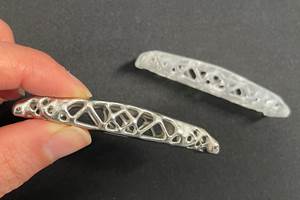Cleaning Before Plating
Our plating operations constantly have problems with surface cleaning prior to plating. Can you offer me any insight on how to solve this problem?
Q: Our plating operations constantly have problems with surface cleaning prior to plating. I’ve been tasked with solving our cleaning problems in what my boss calls an “orderly, reproducible” manner. Can you offer me any insight on how to get started on this project? V.P.
A: First, I must commend your supervisor in attempting to solve this age-old problem in an “orderly, reproducible” manner. Poor surface cleaning is the cause of a very large percentage of plating failures, but surprisingly very little time is spent trying to solve the failures. The typical approach is to try a new cleaner, try running your alkaline cleaner at a higher temperature, and so on. This approach is somewhat hit-or-miss,?but certainly better than doing the same?thing over?and over.
One thing I have learned over the years is that there is no one way to properly clean a surface. There are many examples in which the same material, with the same type of soils on the surface, has been successfully cleaned using different methods. That being said, there are at least three questions that should be asked prior to determining how to clean a surface:
- What is the base material you are cleaning?
- What types of soil are on the surface?
- How old are the soils that are on the surface?
The base material does make a difference. Obviously, a stainless steel has to be cleaned differently than a high-strength steel or an aluminum alloy. For example, a cleaner that will do a good job on a steel can severely damage an aluminum surface.
Different types of soils have to be removed using different methodologies. The surface may contain oxides, cutting and machining fluids from the manufacturing steps, fingerprints, residues from tapes, Magic Marker ink and myriad other possible contaminants. A surface that contains oxides may be easy to clean using a suitable acid. In the case of stainless steel, a Wood’s nickel strike may have to be a critical part of the cleaning process.
Other types of soils may be somewhat of a mystery but quite often can be determined by doing some detective work. By detective work I mean talking to people who have handled the material prior to it arriving in the metal finishing area. Find out what type of fluids are used in the manufacturing of the part. Once you know the materials used in manufacturing you can usually find out the manufacturer’s recommended method of removal from the surface. Tape residues and Magic Marker inks can usually be eliminated by substituting more benign ways of packaging and marking the parts.
The age of the soils on the surface is often ignored. We are probably all familiar with the idea that, as parts age, heavier oxides can form on the surface. We rarely think of the aging of organic materials such as cutting fluids, oils and greases. Upon aging, organic materials can polymerize and become more difficult to remove. This polymerization can occur in the presence of sunlight and heat.
Another point that is worth talking about is this: Do I formulate my own cleaners or do I buy commercially available cleaners? The answer is straightforward: Most people who formulate their own cleaners are trying to save money—an excellent idea, but generally speaking formulated commercial cleaners contain components that make the cleaners function more effectively.
Again, my experience has been that many plating shops pay much less attention to the cleaning process than to the plating process. This is a mistake! Replacing a cleaning process tank after it has failed does not make economic sense once you factor in the cost of the rework. Your alkaline cleaners, acid dips and any other chemistry used in the cleaning steps should be monitored and replaced on a regular basis.
I would suggest that you do some reading on cleaning processes. I am aware of three books that have been published in the last 10 years that have good information about cleaning processes. These books are: Practical Guide to Industrial Metal Cleaning, David S. Peterson; Handbook for Critical Cleaning, edited by Barbara and Edward Kanegsberg; and Management of Industrial Cleaning Technology and Processes, by John B. Durkee II. All three books are available from Amazon.com. ?
Related Content
Possibilities From Electroplating 3D Printed Plastic Parts
Adding layers of nickel or copper to 3D printed polymer can impart desired properties such as electrical conductivity, EMI shielding, abrasion resistance and improved strength — approaching and even exceeding 3D printed metal, according to RePliForm.
Read MoreAn Overview of Electroless Nickel Plating
By definition, electroless plating is metal deposition by a controlled chemical reaction.
Read MoreTroubleshooting Alkaline Zinc
One of the most common problems that can arise when plating with alkaline zinc is an imbalance of brightener in the solution. In this helpful Ask the Expert article, Chad Murphy of Columbia Chemical discusses how different zinc metal concentrations and brightener concentrations can impact efficiency.
Read MoreTrivalent Chrome Overview
As the finishing industry begins to move away from the use of hexavalent chromium to trivalent chromium, what factors should finishers consider as they make new investments? Mark Schario, chief technology officer for Columbia Chemical offers a helpful overview of this complicated topic.
Read MoreRead Next
Education Bringing Cleaning to Machining
Debuting new speakers and cleaning technology content during this half-day workshop co-located with IMTS 2024.
Read MoreDelivering Increased Benefits to Greenhouse Films
Baystar's Borstar technology is helping customers deliver better, more reliable production methods to greenhouse agriculture.
Read MoreEpisode 45: An Interview with Chandler Mancuso, MacDermid Envio Solutions
Chandler Mancuso, technical director with MacDermid Envio discusses updating your wastewater treatment system and implementing materials recycling solutions to increase efficiencies, control costs and reduce environmental impact.
Read More


























